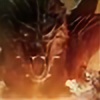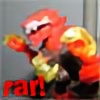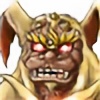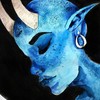HOME | DD
 Transapient — Kaiju Revolution: SKULL ISLAND MENAGERIE 1
Transapient — Kaiju Revolution: SKULL ISLAND MENAGERIE 1

#godzilla #skullisland #godzillakaiju #monstercreature #kaijumonster #transapient
Published: 2018-11-26 23:04:20 +0000 UTC; Views: 39884; Favourites: 533; Downloads: 117
Redirect to original
Description
Ookondoru: These giant avians are among the primary scavengers of Skull Island’s ecosystem. Rarely hunting live prey, they can soar for hours, or even days upon the thermal currents of the island’s mountains and surrounding storm system in search of rotting carcasses. As they feed upon decaying kaiju bodies, their heads and necks inevitably become highly tumorous to the point where their own flesh is constantly sloughing off while continuously regenerating. They fuel this regeneration by rapidly assimilating the carrion they eat, literally becoming a patchwork of what they eat. If denied such food long enough, their heads will eventually rot to nothingness. Thus, they can be highly aggressive when securing a fallen kaiju as their own. As a last-minute defense, they are able to expel a burst of highly lethal radiation that contaminates their surroundings and forms a temporary “shield” upon their own bodies. Wingspan: 40-70 feet.
Chum Worm: These large worm-like creatures presented a mystery to those FATHOM scientists who first described the species. Though thought to have been an offshoot of the mollusk lineage, they are now believed to be a highly derived terrestrial sea-cucumber. They prefer to lurk in dark moist environments, such as super jungle understory or spider pits, where their large eyes can easily detect infrared radiation. Protected mainly by their tough hides, they also employ a particularly gruesome hunting and defensive system. Like their non-kaiju relatives, Chum Worms can self-eviscerate, spraying a mesh of their own intestines upon would-be attackers or prey. These guts, though, are highly automatic and equipped with lamprey-like maws that secrete digestive acids. These will entangle and begin consuming the victim as it is dragged back to the creature’s primary body. It may be that these “guts” were originally separate parasitic organisms before merging symbiotically with their host. Length: 15-25 feet.
Gehara: These rare creatures seem to be derived from therizinosaurs; among the many types of non-avian dinosaur survivors of Skull Island. They are among the few herbivores to regularly enter the large swaths of bamboo forests to feed without fear of the predatory arthropods of the regions. Occasionally, they may even attack such creatures themselves to supplement their diet. Their dense, shaggy feathers form a buffer against attackers, and possess large barbules that cause irritation and even lacerations under some circumstances. A Gehara’s primary weapons, though, are its carbon-fiber claws. These can be wielded to devastating effect against smaller or similarly-sized opponents alike. Fortunately, they are usually quite peaceful unless provoked. The largest individual has taken up residence within a temple ruin now surrounded by the deceptively tranquil bamboo. Height: 70-126 feet.
Malthus Shrew: These deadly predators display hyperdeveloped characteristics of eulipotyphla mammals, such as shrews and solenodons. Their hypervorous metabolisms are highly unstable, forcing them to hunt and feed constantly in order to survive. They are also extremely poisonous, with toxins being secreted within their saliva and the defensive quills along their backs. The poisons are so highly concentrated that even the slightest scratch from their teeth is fatal to many similarly-sized creatures. Their tendency to track prey in groups increases their threat. This deadliness, though, is also their downfall. The volatile toxins their bodies produce are so effective, they themselves eventually begin to succumb to the effects. If not able to find suitable prey on a regular basis, they also tend to turn against each other, consuming even more poisons which hasten the process. Usually, only a few such creatures manage to survive at any given time, but under the right circumstances, a population explosion can become a serious threat to the local ecology. Fortunately, such explosions rarely last long. Length: 7-11 feet.
Rhedosaurus: This reptilian kaiju is a highly adaptable predator. They have been sighted within the jungles and mountains of Skull Island, as well as diving along the coast to great depths. Their conservative body plan grants them access to many habitats, while their armored scales and quill-tipped tails protect them from other predators. Their saliva contains a radioactive venom which they utilize in a similar manner to Komodo Dragons to hunt large prey. They are certainly not picky eaters, though, and will consider most things smaller than themselves as potential meals as well. Though they hunt mostly on land, they often make their dens within a deep channel of water, whether in a lake, river, or the ocean. They seem able to respire oxygen partially through their skin, particularly through pores along their ventral neck region. Rhedosaurs’ adaptability has raised concerns over the possibility of one or more eventually settling away from Skull Island. There are some that suggest they have already done so on occasion. FATHOM archives site a particular incident involving the destruction of several small vessels and a lighthouse along the eastern cost of the Unites States. But this case cannot be fully verified as it was reported about a year before FATHOM’s official formation in 1954 after the definitive discovery of Godzilla. Length: 125-200 feet.
Vine Strangler: These man-sized creatures may not be giant predators, but are stealthy hunters not to be underestimated. Most likely derived from chameleon ancestors, these reptiles are able to alter the color and texture of their skin almost on par with cephalopods. With this ability, they blend seamlessly into the canopies and vine-entangled understories of Skull Island’s jungles. They are able to remain motionless for months at a time, using algae-like cells to respirate and photosynthesize along with the trees they hide upon. When a suitable target is detected, their rib-derived jaws open to an enormous degree and unleash a barrage of several long, muscular tongues. Each tongue is coated in millions of tiny bards whose venom paralyses the unfortunate victim, allowing the Vine Strangler to pull its prey within its torso to be digested. Such a meal can sustain them for years to come, making feeding events a rare occasion. Length: 18-30 feet.
----------
First in a series featuring the creatures of Kaiju Revolution's Skull Island until the main series can begin again. I'll try to upload one of these on a somewhat weekly basis as well.
Creature Inspirations:
Ookondoru; giant condor from Godzilla vs The Sea Monster 1966, and The Giant Claw 1957.
Chum Worm; The Monster that Challenged the World 1957.
Gehara; the quintessential monster of the same name in the short film Gehara 2009.
Malthus Shrew; The Killer Shrews 1959.
Rhedosaurus; The Beast From 20,000 Fathoms 1953.
Vine Strangler; creature featured in Skull Island: The Birth of Kong comic 2017, and Chameleon monster from Godzilla: The Series 1998.
Inspiration was also taken from suggestions by fellow Deviant, Lediblock2. Thanks for the ideas, man.
Related content
Comments: 52

👍: 0 ⏩: 0

BLAZE operative: James
audio log 1:
location: Skull Island
class: ecosystem report
my first day on skull island was quite eventful. We encountered our first predators and lost a few crew. Surprisingly making it through the bamboo jungles, we studied our first herbivore, codenamed Gehara. These therizinosaurs, are actually quite peaceful. We encountered many predators including(but not limited to and using codenames): Ookondoru, Chum Worms, Malthus Shrews, Rhedosaurus, and Vine stranglers. As of currently it is dusk. Operative out.
————colored sketches pending————————
👍: 0 ⏩: 0

1. ookondoru looks like best thing to do is put it out of its misery; i feel sorry for it. two variants: one based on turkey vultures on skull island larger variants that are based on argentavis.
2. chum worm- nice to see an homage to 50s monster movies; mine are dead and remains are in Yuuca Mt, America's nuclear waste depository
3. gehara- the only kaiju that could audition for a cover girl commerical XD
4. maltus shrew- first hypervore of this menagrie; mine live on a quarantined island in the gulf of mexico.
5. rhedosaurus- the kaiju that inspired gojira; remains of mine are found in the American Museum of Natural History. another, larger one will show up
6. Vine strangler- intersting take; i got something similar: Vine Stalker, a herrasaur that hunts like a clouded leopard. will have the chameleon monster in as well but looks more chameleon-like.
👍: 0 ⏩: 0

While not holy original, they do have there own flare
👍: 0 ⏩: 0

The shaggy therizinosaur of nightmares is my favorite!
👍: 0 ⏩: 0

Perfect.
Here's some ideas:
-The servum are derived Rhamphorynchus that have a function similar to tick birds and crocodile birds. Some flocks develop symbiotic relationships to specific kaiju and will even assist them in battle.
-Gabara are oxhyaenid creodonts superficially resembling Persian cats. They have a symbiotic relationship with a biolelectrical, terrestrial barnacle that covers most of their body with only a tuft of red fur running from the head down to the spine. The scale-barnacles channel into their large front claws and allow them to ambush and electrocute young kaiju to feed upon. Believed to have breeding populations in Japan during the feudal era.
-Deutalios are derived archaeocetes convergently similar to giant rats. Common prey on the island.
-Shinomura are gliding velvet worms with extreme regenerative properties. Common food source, but have no limit to their lifespan and the longer one survives, the bigger it can get...
👍: 0 ⏩: 0

Its an assortment of new species, evolved species and prehistoric holdouts. Perfect for Skull Island.
👍: 0 ⏩: 0

do the Chum Worm's weaponized intestines come from it's mouth or it's anus?, if it's the latter then the mouth would just have feathery tentacles like the real Holothurians.
👍: 0 ⏩: 0

I'm kinda surprised to see Gehara (and the worm), nearly forgot Gehara even existed. But, it's also nice to see some good ol' 1950's inspired kaiju.
👍: 0 ⏩: 0

I really like those designs picking elements from several sources and I absolutely ADORE the inclusion of the Rhedosaurus!
👍: 0 ⏩: 1

Thank you. Gotta give credit to the original atomically-awakened reptilian monster.
👍: 0 ⏩: 3

Would it be okay if I drew your creatures?
👍: 0 ⏩: 0

Hope to see some cool and beautiful looking kaiju speices
👍: 0 ⏩: 0

A lovely menagerie!!! I'm surprised to see that you've included Gehara.
👍: 0 ⏩: 1

Thanks, he's just such a strangely cool kaiju I had to give him a shout out.
👍: 0 ⏩: 0

I wish you’d have said how big each one of these are, in relation to each other and your main kaiju.
👍: 0 ⏩: 1

Hmm, yes I think would've been best from the start. Just edited that in now, so hope it makes things a bit clearer. Thanks for pointing that out.
👍: 0 ⏩: 2

i think you should also state how big the animals on mu are.
👍: 0 ⏩: 0

Yes that is better, now I have a sense of sc
👍: 0 ⏩: 0

Thanks. I wonder if anyone else has ever thought of reimagining him as a therizinosaur. I mean, I don't think it's a huge stretch, they look fairly similar in basic outline...
👍: 0 ⏩: 2

Welcome
I don't mind it, though the original kaiju is clearly a carnivore.
👍: 0 ⏩: 0

Mind if I use the therizinosaur idea for my take on Gehara?
👍: 0 ⏩: 1

Yay! You finally posted this! You just made my day!
Good to see Geharha and Rhedosaurus getting some attention, and nice reference to the original Beast from 20,000 Fathoms! What do you actually think of that movie?
👍: 0 ⏩: 1

Thank you. As for the Beast's original movie, while it may not be super-iconic like Godzilla or King Kong, it certainly isn't something to be overlooked. And it does indeed have its share of awesome moments; the lighthouse attack scene, and the ending where the Rhedosaurus burns to death in an amusement park being a couple that come to my mind (I wonder if that ending was partly the inspiration for Gwangi's death at the end of his movie?). It might seem a bit too typical for a monster movie by today's standards, but that's because this was among the first to pioneer that story type. The effects by Ray Harryhausen, though still a bit rough around the edges being one of his earlier works, is still a great and appealing sight to behold. All that being said, there was no way I was going to leave this guy out for KR.
👍: 0 ⏩: 1

Thanks for sharing your thoughts! As for me, the Beast from 20,000 Fathoms is one of my favourite movies.
👍: 0 ⏩: 0

Amazing!! I always thought Rhedosaurus would work well on Skull Island. I have a small problem with these creatures with two dying if they don't get enough sustenance, I don't think this would a little more rare.
Other than that I love it!!
👍: 0 ⏩: 1

Thank you. The idea I was working off of for hypervorous creatures like the shrews and condors stem from what is mentioned of the design process behind the Skullcrawlers in the Kong: Skull Island art book, in which they were designed as "bastards of evolution".
👍: 0 ⏩: 1

As per friggin always... YOU ARE AMAZING!!!!!!
The Vine-Strangler Is soo cool and eerie, but kindda confuses me with its unusual feeding habits...
1) Y dat mouth if it got tummy tentacles?
2) Y not lots mouthy tentacles?
3) Y u always so Badass!!!
👍: 0 ⏩: 1

I recognised all their sources, except the vine strangler..
👍: 0 ⏩: 1

Yeah, that one's mainly just the name and hunting strategy. Even its profile in the comic is kinda sketchy, perhaps due to it never making it much past the conceptual stage, and aside from the aforementioned profile it doesn't shown up directly in the comic either. Most of the design came from the monster featured in Godzilla: The Series.
👍: 0 ⏩: 0

this is awesome, i love the the vine strangler, still waiting for the Rat Monkey.
there is a rather mediocre film called Demeking, about the titular extraterrestrial Kaiju which resembles a four-legged slug, would it be part of KR?.
👍: 0 ⏩: 1

That damn thing's giving me a headache...
Huh, I actually never heard of that one. Let me look that up........ Oh man, this should be interesting. Thanks for bringing this to my attention!
👍: 0 ⏩: 0

nice love that you gotten some of the old school monsters in here
👍: 0 ⏩: 1

Thanks, there should be others like that popping up along the way.
👍: 0 ⏩: 0

Glad to know that I wasn't delusional when I recognized Ookondoru, heh heh.
The Malthus Shrew though. Geez, Mother Nature's really stumbled on an evolutionary gamble there. (Guess you could say the same for the Ookondoru as well. Yikes.)
Really interesting insight into the wildlife of Skull Island! So far the creatures are deliciously weird, cool, horrifying, and other equally-flattering terms.
👍: 0 ⏩: 1

Thank you very much, did you catch the Giant Claw inspiration as well?
👍: 0 ⏩: 1

I've heard of the Giant Claw, but I'm not too familiar with it.
👍: 0 ⏩: 1
| Next =>

























